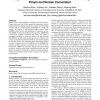Free Online Productivity Tools
i2Speak
i2Symbol
i2OCR
iTex2Img
iWeb2Print
iWeb2Shot
i2Type
iPdf2Split
iPdf2Merge
i2Bopomofo
i2Arabic
i2Style
i2Image
i2PDF
iLatex2Rtf
Sci2ools
CIKM
2007
Springer
2007
Springer
A segment-based hidden markov model for real-setting pinyin-to-chinese conversion
Hidden markov model (HMM) is frequently used for Pinyin-toChinese conversion. But it only captures the dependency with the preceding character. Higher order markov models can bring higher accuracy, but are computationally unaffordable to average PC settings. We propose a segment-based hidden markov model (SHMM), which has the same magnitude of complexity as firstorder HMM, but generates higher decoding accuracy. SHMM tells a word from a bigram connecting two words, and assigns a reasonable probability to words as a whole. It is more powerful than HMM to decode words containing over two characters. We conduct a comprehensive Pinyin-to-Chinese conversion evaluation on Lancaster corpus. The experiment shows the perfect sentence accuracy is improved from 34.7% (HMM) to 43.3% (SHMM). The one-error sentence accuracy is increased from 72.7% to 78.3%. Furthermore, SHMM can seamlessly integrate with pinyin typing correction, acronym pinyin input, user-defined words, and selfadaptive learning a...
CIKM 2007 | Hidden Markov Model | Information Management | Segment-based Hidden Markov | Sentence Accuracy |
| Added | 13 Aug 2010 |
| Updated | 13 Aug 2010 |
| Type | Conference |
| Year | 2007 |
| Where | CIKM |
| Authors | Xiaohua Zhou, Xiaohua Hu, Xiaodan Zhang, Xiajiong Shen |
Comments (0)

